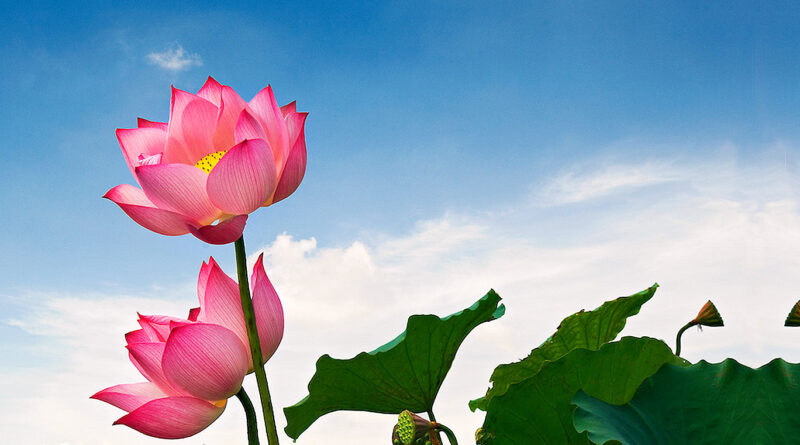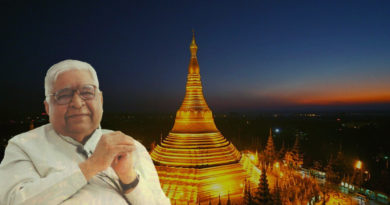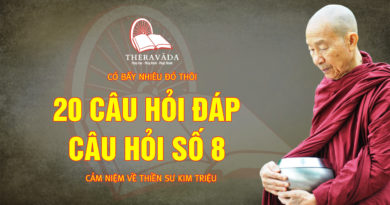The Middle Path
-By Mr. S. N. Goenka
During the time of the Buddha two traditions were very popular in the country.
First – Kāmesu-kāmsukkhallikānuyogo (attachment to worldly enjoyment of sensual pleasures), which means assuming sensual pleasures as the cause of one’s happiness one remained attached to them. It was definitely an inferior path. It was a path for the ignoble people (Anārya) who disdained the path of Dhamma. Clearly it was a wrong path doing well to none.
One disgraceful tradition prevalent from very ancient times assumed that happiness in life comes through sensual pleasures only. It also did not believe in the rebirth of any being. The birth meant only the present life. So, one should enjoy this life as much as possible by enjoying sensual pleasures. Ajit Kesakambala, a contemporary of the Buddha said that as there is no restriction on the sexual relationship between parents and children amongst birds and animals as one can see amorous relations between the son and mother as the son becomes young and between the daughter and father as the daughter grows up and as this law applies to all animals and birds, insects and flies and reptiles so this law of nature applies to human beings also. There should be no restriction on such relationship. Thus, the ascetic Kashyap says – kuto mata (no mother, why talk of mother?), kuto pita (no father, why talk of father?)
This belief in unrestricted sexual relationship and doing as one likes has been prevalent since ancient times in lesser or greater degree. Descriptions of illegal sexual relationships between ascetics and maid servants are found in ancient literature. At one place, there is a prayer requesting a god named ‘Brahmaspati’ that a boy named ‘Kaksīvana’ born from the womb of one sensual maid servant named ‘Usij’ be included in the category of the gods to share the sacrificial offerings. (Rgveda – 1-5-18-1)
Description of the despicable sexual misconduct committed forcefully by Prajāpati Brahmā with his daughter is also available. (Rgveda 10-5-61-7). Similarly, instances of sexual and illegal relationships between father and daughter and mother and son have also been mentioned (Atharva veda 8-6-7). In the same way, description of an indecent conversation between brother and sister (Yama and Yamī) in respect of sensual pleasures is also well-known. (Ṛgveda – 10-1-10-7/11).
Apart from these, other instances of illegal sexual conduct are also evident before us. Maharsi (a great ascetic) Parāsara had sexual relationship in a boat with Satyavatī –the daughter of a Kevata (boatman). Maharsi Viswāmitra’s lustful conduct with Urvasī is also known to everybody.
Kāma evaikah purusārthah.
-(Bārhaspatyasūtra – 5)
— The one and only goal of life is to have lustful pleasure. Thus, it is the best.
Angnālingnājjanyasukhamev pumarthatā|
-(Sarvadaroeansangraha – 1.4)
— The pleasure one gets by embracing a woman is a mark of manliness.
Such people regarded only the uninhibited sexual pleasures as the greatest happiness of life and believed that indulgence in it is the greatest success of life.
We find instances of such illegal sexual conduct later also. As one hedonist (Bhogavādī) has said –
“Yāvajjīvet sukham jīvet, rnan krtvā ghrtam pibet; Bhasmībhūtasya dehasya, punrāgamanam kutah”
-(Bārhaspatyasūtra –45)
— So long as one lives he should live happily. He should drink ghee (clarified butter) even if he had to buy it by taking loan. Where is the rebirth of a dead body turned into ashes?
When there is no rebirth which action should we consider as unwholesome to fear from its result?
Whereas many ancient texts are full of exhortations on the pure and true Dhamma, descriptions of such unethical acts prove the prevalence of such sexual misconducts since time immemorial.
There was no dearth of such ideology even during the time of the Buddha. The influence of such promiscuous behavior is seen in what Ajita Keskambala believed. According to his opinion ‘Natthi Mātā, Natthi Pita’ (No Mother, No Father) type of dissolute sexual misconduct also prevailed at that time. The Perfectly Enlightened One called all such acts of sexual misconduct the path of extremity and said in this connection that remaining engrossed in such sexual misconduct was the path of the lowly, of the rustic and ignoble beings, fallen and far away from Dhamma, which was clearly the path leading one to ruin.- (Yo cāyam kāmesu kāmasukhallikānuyogo, hīno gammo pothujjaniko anariyo anatthasamhito).
The ascetic Siddhārtha did not set even a single step on this extreme path, which was blameworthy.
The second extremity was inflicting severe pain on one’s body. This path was full of severe penance and self- mortification, practiced by the ignoble beings leading to their ruin. (Attakilamathānuyogo dukkho anario anatthasamhito).
Inflicting pain on the body by remaining hungry was believed to be a very good ascetic practice in those days.
For example –
Some ascetics always remained naked, rejecting all ethical conventions, licking the plate and hand after the meals. They would not accept alms from those who would invite them by saying ‘Come Bhante’ and say ‘Go Bhante’ when going. They would not accept alms from those who would give them after asking them ‘please stop’ or from those who invite them. They would not accept food if it were specially prepared for them and if it were brought straight from the cooking pot. They would not receive food if it was brought across a stick, across a mortar and pestle, if it was brought while two persons were eating. They would not accept it from a pregnant woman, from a woman giving suck, from an immoral woman visiting other men, from one who has prepared food by collecting donation or contribution. They would not take the food from where a dog was standing or flies were buzzing. They accepted no cooked fish nor meat, nor wine, liquor, nor fermented brew.
They visited only one home for food, took only one morsel, visited two homes and took two morsels…visited seven homes and took seven morsels. They would live on one saucer full a day, on two saucer full a day… on seven saucer full a day. They would eat every alternate day, every after two days … and every after seven days or once every fortnight.
Some ascetics and Brahmins lived on only greens and vegetables. They led their lives by eating only wild rice or paddy or moss or rice bran or rice-scum or sesamum flour or grass or cow dung or they lived on forest roots and fruits.
Some ascetics clothed themselves in hemp, in shrouds, in refuse rags, in tree bark, in antelope hide, in kusa-grass fabric, in bark fabric, in wood-shavings fabric, in head-hair wool, in animal wool, in the owls’ wings.
They plucked out their hair and beard by pulling, squatted on the ground, slept on thorns, planks and on the ground, slept on one side, rubbed dust on their bodies and slept in the open, sat at whatever places were available to them, ate unclean and rotten things, drank polluted and dirty water. They bathed three times in the morning, afternoon and evening every day.
Some of them remained without food for a fortnight and regarded this practice as a form of great meditation. They were unable to practice morality, concentration and wisdom by controlling their mind and were far away from experiencing them.
The sākya prince also tried many such ascetic practices of self – mortification. In his own words – “At that time, I thought why not I, clench my teeth and press my tongue against the roof of my mouth to subjugate mind with mind. Then, clenching my teeth and pressing my tongue against the roof of my mouth, I subjugated my mind with mind, crushed and tormented it. Doing so, I started sweating just as a weak man would sweat when seized by the head or by the shoulders, crushed and tormented and shaken violently by a strong man. In this way, sweat streamed from my armpits. At that time tireless energy was aroused in me. Though physically exhausted due to severe self -mortification my mindfulness was unremittingly established and I remained fixed on this painful path to attain absolute freedom from suffering.
After that I thought why not I practice meditation without breathing. So I stopped the incoming and outgoing breaths from my nose and mouth. As I did so, there was a loud roaring of winds coming out of my ear holes, just like the loud roar of winds coming out of a smith’s bellows. At that time tireless energy was aroused in me. Though physically exhausted due to severe self- mortification my mindfulness was unremittingly established and my body was ready to attain absolute freedom from suffering.”
The delicately nurtured ascetic Prince who had lived a luxurious life practiced difficult asceticism resolutely and experimented with all kinds of self- mortification to their highest limit. Various types of severe austerities and self-mortifications prevalent at that time, were tried and inflicted by him on his body.
And when he turned to observe fasting, he fasted to such an extent that his body became extremely emaciated. Nowhere was there any sign of flesh and marrow in it. What remained was only a skeleton of bones and withered skin. At the age of 35, he began to look even worse than an old man of 80. The golden complexion of his impressive body turned black. Layers of dirt and filth became accumulated at several places on his body. His buttocks became like a camel’s hoof. The higher and lower protruding columns of his spine became like a twisted munj rope. The ribs jutted out like the jutting rafters of an old, run-down house. The pupil of the eye sank deep in the eye socket like the reflection of a star in a deep well. The scalp became like a green bitter gourd, shriveled & withered in the heat. The skin of belly stuck to the spine and when he tried to touch his belly, he grabbed a vertebra. The body became so feeble and emaciated that if he tried to get up by giving support to any limb with his hands, the rotten hairs of that place fell with their roots from his body. If he wanted to answer the call of nature he could not walk even one step. He would fall down crashing on the ground. Such was the extremity of his self -mortification and austerities.
After practicing such hard and arduous austerities and self- mortification for about six years, he found that the inherent klesas within the depths of his subconscious mind remained as they were before. There was no change at all in them.
Then he understood that just as a person living a luxurious life of sensual pleasures lives a life of one extreme and remains far away from his liberation, in the same way, a person practicing severe austerities and self-mortification, lives a life of another extreme. He also is far away from being liberated. What is important is the purification of mind. It has to be freed from defilements. For attainment of freedom from suffering, the middle path has got to be searched giving up these two extreme paths.
Thus, by eating proper food he made his body regain strength for practicing meditation and applied himself to search for the middle path within himself. Facing many internal obstacles, finally the infinite strength of his wholesome merits, gained and accumulated from his past innumerable lives, arose and the path of Vipassana – the Noble Eight Fold Path leading to liberation was discovered.
Abandoning both the extreme paths leading to harm and ruin the Buddha discovered the Middle Path (Majjhimā Patipadā) and taught the same to the people. This is the path, which leads one to attain direct knowledge, self-awakening, and Nibbāna (Liberation). He called this the Noble Eight-fold Path (Ariyo Atthangiko Maggo) — the path consisting of eight constituents. This is a Noble Path in the sense that any ignoble person, if he adopts this path and walks on it, is sure to become a noble one.
That sensual pleasure is a fetter became clear to him. It also became clear to him that practicing asceticism is useless. The rituals are of no use. Belief in different philosophical views broke down. With the strength of experiential wisdom, developed on the basis of personal experience, wrong view based on blind beliefs was replaced by the right view. In place of the confusing knowledge based on intellectual thinking, right knowledge based on direct personal experience was developed. The imaginary liberation became directly experienced one. The most beneficial sammā-sambodhi (self-awakening) was attained. All innermost causes of suffering were destroyed. The mind became absolutely free from all defilements. He attained liberation by wisdom. The timeless, eternal, subtle, peaceful, ultimate truth was realized. Prince Siddhārtha became the Perfectly Enlightened One by attaining enlightenment.
The Dhamma fraternity continued with their pure mission of spreading the Buddha Dhamma in the North India. Many wise people easily accepted this path because there was no blind faith or superstition in it. Meditation develops on the basis of direct experience that one has and because it is scientific it also starts giving good results. All actions done and their results become wholesome as a result of practicing meditation. This truth became clear to many and they very happily decided to walk on this easy and pure path.
However, many people in this big country of India were still attached to various forms of blind dogmas and blind beliefs. They had difficulty in understanding and adopting this natural and easy path. But those who did were immensely benefited by it. After abandoning these blind dogmas and blind beliefs let us walk on this path step by step and attain our own welfare and happiness.
Source: https://www.vridhamma.org


![Video Sayagyi U Ba Khin Bbc Budismo Birmanês ) 1950s [ Inglês ] 2 Untitled 2](https://satima.net/wp-content/uploads/2021/04/Untitled-2-390x205.jpg)

